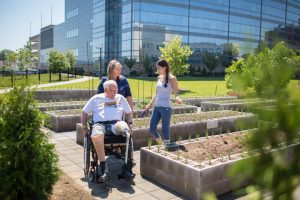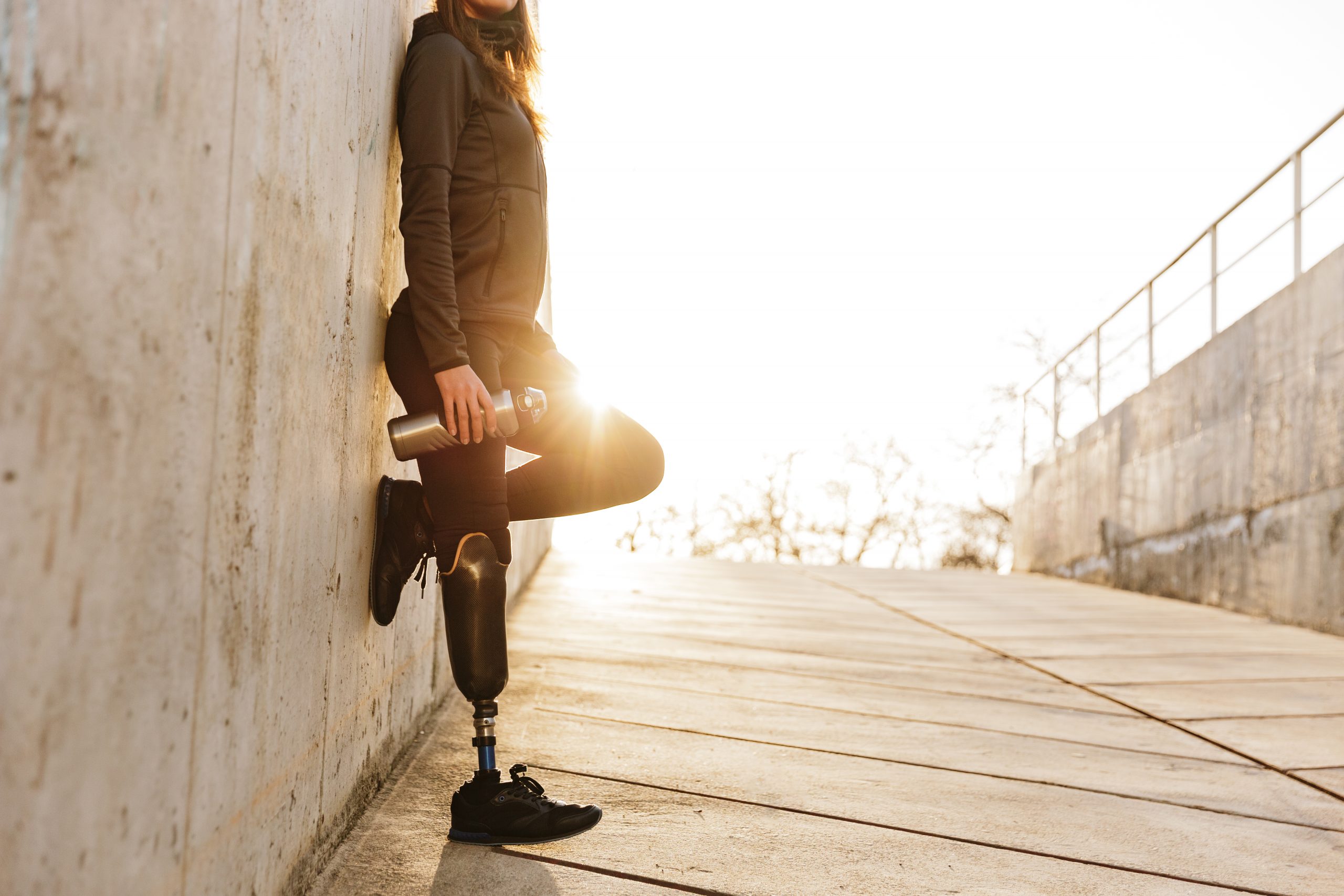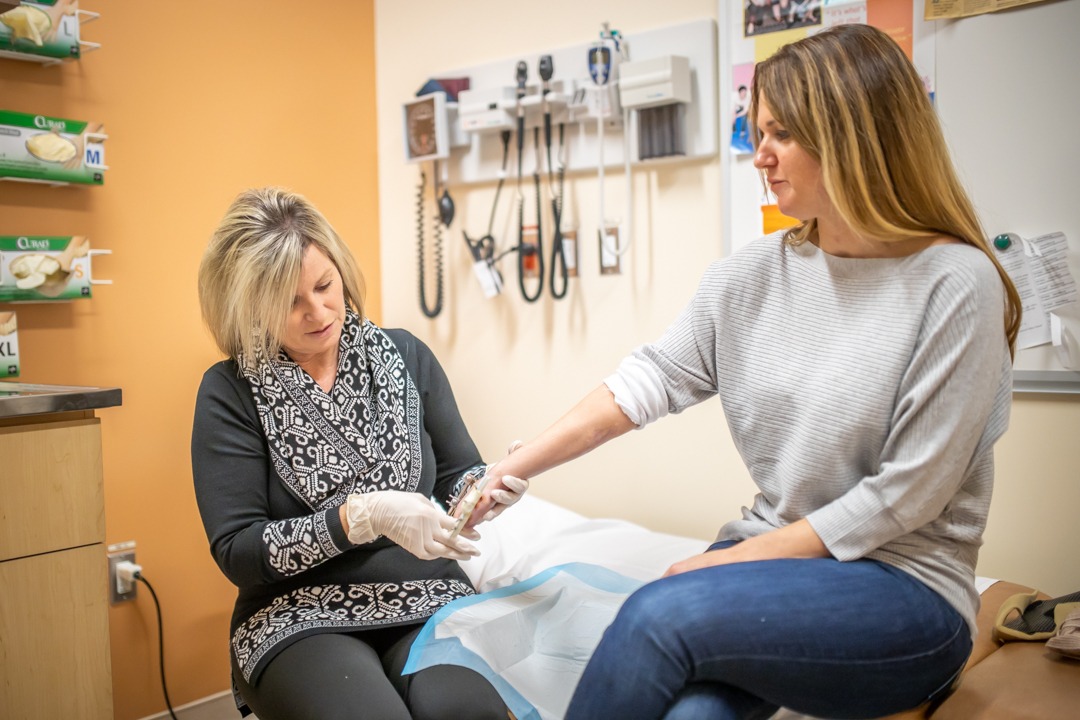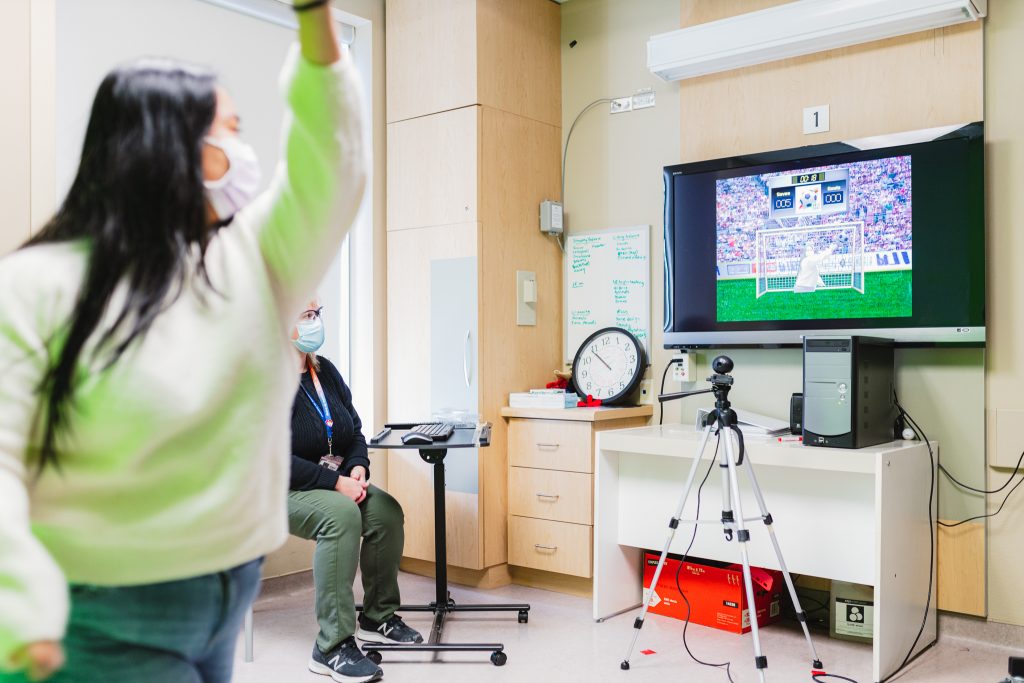
Virtual reality games make rehab fun for amputee patients
Lyndyl Smith isn’t the sporty type.
“My favourite pastimes are reading, calligraphy and spending time with friends,” says the 21-year-old university student and Hamilton Health Sciences (HHS) patient.
Yet just a few weeks after undergoing an amputation below her right knee, Smith found herself blocking soccer balls and snowboarding down a mountain as part of the amputee rehabilitation program at HHS’ Regional Rehabilitation Centre.
“Virtual reality made rehab really fun.”
Snowboarding, soccer, and even parachuting are among the virtual reality (VR) activities offered to patients as part of a six-week amputee rehabilitation program. Patients visit the hospital for daily programming that includes seeing physiotherapists and physiotherapy assistants, occupational therapists and occupational therapy assistants, and counselling services. These professionals help patients who recently had a limb amputated adjust to their new normal.
The VR activities help patients improve skills like balance, range of motion and mobility. Programming is led by the hospital’s recreation therapists in partnership with occupational therapists.
Patients stand in front of a green screen wall, and a camera projects them onto a large screen showing one of the virtual reality games. They are immersed in the digital experience and become part of the game itself.
Inspiring future careers
“Virtual reality made rehab really fun,” says Smith, who was so inspired by her experience at the Regional Rehabilitation Centre, she abandoned her plans to study accounting at university and enrolled in University of Waterloo’s therapeutic recreation program instead.

Lyndyl Smith’s experience at the HHS Regional Rehabilitation Centre inspired her to study therapeutic recreation at university.
Recreation therapists use recreation, leisure and play as part of a patient’s rehabilitation.
“My experiences at the Regional Rehabilitation Centre pushed me towards this career,” says Smith, of Oakville, who is finishing her third year of the four-year program.
Fun and interactive rehab games
Smith was born with malformed feet that made walking extremely challenging. Her right leg was weaker and more painful than the left. So at age 19, she opted to have it amputated below the knee since an artificial limb would make walking easier and less painful.
The surgery took place in November, 2018. She recovered at home, and in the spring of 2019 Smith took part in the six-week amputee rehabilitation program for medical day patients.
“It’s offered in a group format,” says Smith, adding that her fellow group members were all senior citizens. In spite of the age difference, she found it easy to connect with the participants. “Programming was a lot of fun and very interactive.”
No one in her group had tried VR before. “I didn’t grow up playing video games,” says Smith, adding that some group members caught on very quickly. “It was a lot of fun doing VR as a group. Some people would get quite competitive.”

Kathie Elstone, HHS recreation therapist
The amputee rehabilitation program has offered VR for about six years and is currently in the process of upgrading the technology, thanks to a donation from a former patient’s family.
Amputee rehabilitation program
The program’s interdisciplinary team includes a physician, recreation therapists, physiotherapists, occupational therapists, a social worker, prosthetic and orthotic technicians, nurses, a pharmacist and a dietitian.
“We can show patients that life goes on after an amputation.”
Depending on medical needs, patients with recent amputations are referred to an inpatient or medical day patient rehab program, where services include getting fitted for a prosthetic limb and learning to use it. Both inpatient and medical day care patients may take part in VR programming as part of their rehabilitation.
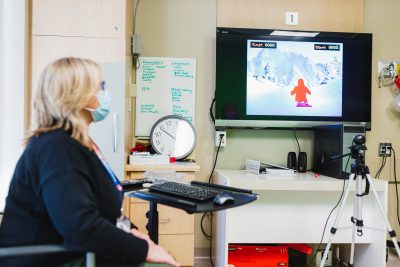
Recreation therapist Kathie Elstone demonstrates the downhill skiing option for patients who use virtual reality as part of their rehabilitation exercises.
Patients are assessed to see how they’re managing with their new prosthesis, says Kathie Elstone, a recreation therapist with the program. “We start out simple, to assess such things as a person’s ability to balance, reach for objects and shift their weight. These are important skills for day-to-day life.”
Easier VR activities include playing the drums, and a game where patients reach for eggs that transform into birds when touched.
From there, patients can choose to try more challenging VR experiences like sports. With soccer, patients play goalie where skill sets include balance, reaching, bending and stretching. This game also helps with reflexes since the ball can move towards them at varying speeds. Parachuting is another more advanced VR activity. It encourages multitasking, as patients concentrate on keeping their chute straight while at the same time avoiding virtual obstacles in the sky like birds and storm clouds.
“You get so immersed in the activity that you don’t even realize how much it’s helping to improve your mobility,” says Smith.
All VR games encourage some level of multitasking, by keeping participants’ minds on both the game and their movement.
“When patients first get their prosthesis, they’re very focused on it, and how they’re walking with it,” says Elstone, adding that the vast majority of patients in the program have lower limb amputations.
“In real life, they need to be able to multi-task. The VR games help with this because patients must focus on an activity while also being mindful about what’s happening with their prosthesis.”
Patients can also continue to enjoy favourite pastimes through VR games. “Someone who loves music may really enjoy the drumming,” says Elstone. “And if a patient played a sport before their amputation, VR can help them explore what that sport might look for them now, and where they can play in the community.”
Making therapy fun
Having an amputation is a huge life change that can cause feelings of loss, depression and anxiety in some patients.
“As you can imagine, someone who has gone through an amputation is going through a very difficult time in their life,” says Elstone. “The VR experience can help people to work through this. We have the element of fun in our therapy. We can show patients that life goes on after an amputation, and they can continue to do activities that they enjoy.”
Smith agrees.
“The virtual reality that we did — me and the people in my program — would bring out the competitive side in you. But you’re also practicing your skills,” she says. “Being here in virtual reality, you focus on the activity itself. It’s a good way of doing activities without realizing that you’re being independent.”

